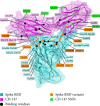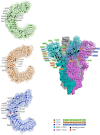The Possible Mechanistic Basis of Individual Susceptibility to Spike Protein Injury
- PMID: 40599824
- PMCID: PMC12213048
- DOI: 10.1155/av/7990876
The Possible Mechanistic Basis of Individual Susceptibility to Spike Protein Injury
Abstract
Injury from spike protein, whether induced by COVID-19 infection or vaccination, constitutes a significant health concern for numerous individuals. Considerable heterogeneity exists in individual responses to both COVID-19 infection and vaccination, despite the latter being principally more controlled and consistent than the wide variety of infection circumstances. This review explores the possible mechanisms by which the spike protein contributes to cellular and systemic damage, highlighting the importance of understanding these processes for developing effective diagnostics and treatments.
Copyright © 2025 Matthew Halma et al. Advances in Virology published by John Wiley & Sons Ltd.
Conflict of interest statement
The authors declare no conflicts of interest.
Figures








Similar articles
-
Systemic pharmacological treatments for chronic plaque psoriasis: a network meta-analysis.Cochrane Database Syst Rev. 2021 Apr 19;4(4):CD011535. doi: 10.1002/14651858.CD011535.pub4. Cochrane Database Syst Rev. 2021. Update in: Cochrane Database Syst Rev. 2022 May 23;5:CD011535. doi: 10.1002/14651858.CD011535.pub5. PMID: 33871055 Free PMC article. Updated.
-
Surveillance for Violent Deaths - National Violent Death Reporting System, 50 States, the District of Columbia, and Puerto Rico, 2022.MMWR Surveill Summ. 2025 Jun 12;74(5):1-42. doi: 10.15585/mmwr.ss7405a1. MMWR Surveill Summ. 2025. PMID: 40493548 Free PMC article.
-
Immunogenicity and seroefficacy of pneumococcal conjugate vaccines: a systematic review and network meta-analysis.Health Technol Assess. 2024 Jul;28(34):1-109. doi: 10.3310/YWHA3079. Health Technol Assess. 2024. PMID: 39046101 Free PMC article.
-
Systemic pharmacological treatments for chronic plaque psoriasis: a network meta-analysis.Cochrane Database Syst Rev. 2017 Dec 22;12(12):CD011535. doi: 10.1002/14651858.CD011535.pub2. Cochrane Database Syst Rev. 2017. Update in: Cochrane Database Syst Rev. 2020 Jan 9;1:CD011535. doi: 10.1002/14651858.CD011535.pub3. PMID: 29271481 Free PMC article. Updated.
-
Signs and symptoms to determine if a patient presenting in primary care or hospital outpatient settings has COVID-19.Cochrane Database Syst Rev. 2022 May 20;5(5):CD013665. doi: 10.1002/14651858.CD013665.pub3. Cochrane Database Syst Rev. 2022. PMID: 35593186 Free PMC article.
References
-
- Halma M. T. J., Rose J., Lawrie T. The Novelty of mRNA Viral Vaccines and Potential Harms: A Scoping Review. D-J Series . 2023;6(2):220–235. doi: 10.3390/j6020017. - DOI
Publication types
LinkOut - more resources
Full Text Sources

